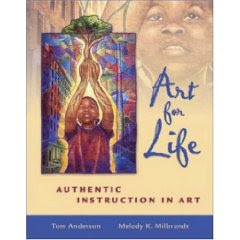Joni Hough
February 9, 2010
ARTE 5122
Multicultural Artworlds: Chapter 2 Summary/Response
Erickson defines artworlds as subcultures focused on art that have developed within the larger cultures of various ethnic groups. The artwork created within these artworlds can carry meaning for the larger culture and can be a resource for understanding that culture. These artworlds can also be a central concept around which a multicultural art curriculum is structured.
There are many distinct, yet interrelated artworlds in North America, including the mainstream museum artworld, folk artworlds, commercial artworlds, ceremonial artworlds, and artworlds of many ethnic groups. Within any ethnic group, there are diverse, evolving, overlapping artworlds.
To understand a culture one must understand that culture’s ideas and activities. Studying important people and places within a culture provides concrete examples to help explain that culture’s ideas and activities to students.
Artworlds serve several different functions. For example, different artworlds have different definitions of what constitutes art. Teaching students about diverse artworlds, allows them to more broadly define art for themselves. Artworlds also enable art making, by offering artists support and education. By learning about many artworlds, students have the opportunity to discover the knowledge that is maintained and passed on by those artworlds. Artworlds provide meaning for artworks. If students are not taught about the contextual artworld in which an artwork is made, they can not fully appreciate that artwork. Art not only reflects the artworld in which it is made, it also affects society. By understanding a variety of artworlds, student can recognize the many ways art functions in different cultures. Finally, artworlds offer support to those who wish to make art and to those who wish to understand art. Students who have access to myriad artworlds have access support systems they can use for lifelong learning.
My Response
This chapter has given me a new perspective on how to address my art issue assignment. The issue of “Western art is modern and non-Western art is traditional” is too narrow a view of art. This idea ignores a vast majority of artworlds from both Western and non-Western cultures. There are so many more artworlds than just modern or traditional. I knew I disagreed with that statement, however before reading this chapter, I could not satisfactorily explain to myself why I disagreed with it.
Also, I agree with this chapter that students need to learn about artworlds and understand the context of artworks. However, I think that having student compare and contrast different artworlds, without creating hierarchical categories, would give students a more comprehensive understanding of art.






I just ran across your blog- I really like it here! Lots of food for thought!
ReplyDeletehttp://2soulsisters.blogspot.com/
Thank you. I should be adding quite a bit more information soon.
ReplyDelete